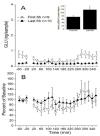Extended access to cocaine self-administration results in reduced glutamate function within the medial prefrontal cortex
- PMID: 22339852
- PMCID: PMC3360114
- DOI: 10.1111/j.1369-1600.2011.00428.x
Extended access to cocaine self-administration results in reduced glutamate function within the medial prefrontal cortex
Abstract
Previous studies have shown that brief access to cocaine yields an increase in D2 receptor binding in the medial prefrontal cortex (mPFC), but that extended access to cocaine results in normalized binding of D2 receptors (i.e. the D2 binding returned to control levels). Extended-access conditions have also been shown to produce increased expression of the NR2 subunit of the N-Methyl-D-aspartate receptor in the mPFC. These results implicate disrupted glutamate and dopamine function within this area. Therefore, in the present study, we monitored glutamate and dopamine content within the mPFC during, or 24 hours after, cocaine self-administration in animals that experienced various amounts of exposure to the drug. Naïve subjects showed decreased glutamate and increased dopamine levels within the mPFC during cocaine self-administration. Exposure to seven 1-hour daily cocaine self-administration sessions did not alter the response to self-administered cocaine, but resulted in decreased basal dopamine levels. While exposure to 17 1-hour sessions also resulted in reduced basal dopamine levels, these animals showed increased dopaminergic, but completely diminished glutamatergic, response to self-administered cocaine. Finally, exposure to 17 cocaine self-administration sessions, the last 10 of which being 6-hour sessions, resulted in diminished glutamatergic response to self-administered cocaine and reduced basal glutamate levels within the mPFC while normalizing (i.e. causing a return to control levels) both the dopaminergic response to self-administered cocaine as well as basal dopamine levels within this area. These data demonstrate directly that the transition to escalated cocaine use involves progressive changes in dopamine and glutamate function within the mPFC.
© 2012 The Authors, Addiction Biology © 2012 Society for the Study of Addiction.
Figures







Similar articles
-
Changes in levels of D1, D2, or NMDA receptors during withdrawal from brief or extended daily access to IV cocaine.Brain Res. 2007 Feb 2;1131(1):220-8. doi: 10.1016/j.brainres.2006.10.069. Epub 2006 Dec 11. Brain Res. 2007. PMID: 17161392 Free PMC article.
-
Effect of 6-hydroxydopamine lesions of the medial prefrontal cortex on intravenous cocaine self-administration under a progressive ratio schedule of reinforcement.Pharmacol Biochem Behav. 1996 Jan;53(1):5-9. doi: 10.1016/0091-3057(95)00192-1. Pharmacol Biochem Behav. 1996. PMID: 8848459
-
Prefrontal glutamate release into the core of the nucleus accumbens mediates cocaine-induced reinstatement of drug-seeking behavior.J Neurosci. 2003 Apr 15;23(8):3531-7. doi: 10.1523/JNEUROSCI.23-08-03531.2003. J Neurosci. 2003. PMID: 12716962 Free PMC article.
-
Cortical mechanisms of cocaine sensitization.Crit Rev Neurobiol. 2005;17(2):69-86. doi: 10.1615/critrevneurobiol.v17.i2.20. Crit Rev Neurobiol. 2005. PMID: 16808728 Review.
-
Comparison of cocaine- and methamphetamine-evoked dopamine and glutamate overflow in somatodendritic and terminal field regions of the rat brain during acute, chronic, and early withdrawal conditions.Ann N Y Acad Sci. 2001 Jun;937:93-120. doi: 10.1111/j.1749-6632.2001.tb03560.x. Ann N Y Acad Sci. 2001. PMID: 11458542 Review.
Cited by
-
Effects of chronic cocaine self-administration and N-acetylcysteine on learning, cognitive flexibility, and reinstatement in nonhuman primates.Psychopharmacology (Berl). 2019 Jul;236(7):2143-2153. doi: 10.1007/s00213-019-05211-5. Epub 2019 Mar 15. Psychopharmacology (Berl). 2019. PMID: 30877326 Free PMC article.
-
Limited versus extended cocaine intravenous self-administration: Behavioral effects and electrophysiological changes in insular cortex.CNS Neurosci Ther. 2021 Feb;27(2):196-205. doi: 10.1111/cns.13469. Epub 2020 Oct 29. CNS Neurosci Ther. 2021. PMID: 33118700 Free PMC article.
-
Chronic cocaine disrupts mesocortical learning mechanisms.Brain Res. 2015 Dec 2;1628(Pt A):88-103. doi: 10.1016/j.brainres.2015.02.003. Epub 2015 Feb 20. Brain Res. 2015. PMID: 25704202 Free PMC article. Review.
-
A Spatio-temporal Model for Detecting the Effect of Cocaine Use Disorder on Functional Connectivity.Spat Stat. 2021 Oct;45:100530. doi: 10.1016/j.spasta.2021.100530. Epub 2021 Jul 21. Spat Stat. 2021. PMID: 34804784 Free PMC article.
-
The cognitive cost of reducing relapse to cocaine-seeking with mGlu5 allosteric modulators.Psychopharmacology (Berl). 2020 Jan;237(1):115-125. doi: 10.1007/s00213-019-05351-8. Epub 2019 Aug 24. Psychopharmacology (Berl). 2020. PMID: 31446451
References
-
- Abekawa T, Ohmori T, Ito K, Koyama T. D1 dopamine receptor activation reduces extracellular glutamate and GABA concentrations in the medial prefrontal cortex. Brain Res. 2000;867:250–254. - PubMed
-
- Ahmed SH, Koob GF. Transition from moderate to excessive drug intake: change in hedonic set point. Science. 1998;282:298–300. - PubMed
-
- Allen RM, Dykstra LA, Carelli RM. Continuous exposure to the competitive N-methy1-D: -aspartate receptor antagonist, LY235959, facilitates escalation of cocaine consumption in Sprague-Dawley rats. Psychopharmacology (Berl) 2007;191:341–351. - PubMed
-
- APA. Diagnostic and statistical manual of mental disorders. 4th. American Psychiatric Association; Washington, DC: 2000.
-
- Bechara A, Damasio H. Decision-making and addiction (part I): impaired activation of somatic states in substance dependent individuals when pondering decisions with negative future consequences. Neuropsychologia. 2002;40:1675–1689. - PubMed
Publication types
MeSH terms
Substances
Grants and funding
LinkOut - more resources
Full Text Sources

